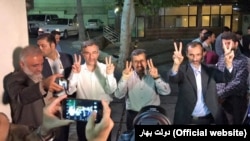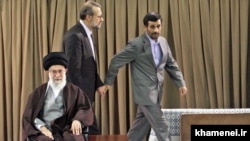The following analysis is based on an op-ed by Radio Farda analyst Majid Mohammadi and a number of interviews and discussions on Farda's radio programs.
In recent days Iran's former president Mahmoud Ahmadinejad and his close allies have harshly attacked the establishment of the Islamic Republic, calling them “tyrants”, “corrupt” and predicted their “imminent fall”.
Observers now ask whether Ahmadinejad is about to form a new opposition that operates outside the norms of the Islamic Republic?
During its 38 year existence, the Iranian regime has been successful in eliminating all opposition groups and parties within the country that challenged its structure and leaders.
The “wagon of the system”, as the Supreme Leader Ayatollah Ali Khamenei refers to the circle of the ruling elite, has been so cramped that even several high-ranking officials, including former presidents, have been kicked out of it.
Mahmoud Ahmadinejad, who served two terms as Iran's president from 2005 to 2013, is one of them. He was barred by Khamenei for running as a candidate in the May’s presidential election.
But he did not obey the leader, signed up for the election and consequently was disqualified by the Guardian Council that is under the control of the leader.
Many thought that Ahmadinejad’s political career is over and he will retreat from the scene and return to his private life.
But his controversial public appearances, including the one on Wednesday July 26th let observers speculate that he had not only an astonishing perseverance, but had a long-term plan for creating a new opposition force that challenges the traditional framework.
In such a role, Ahmadinejad will not only face a significant segment of conservatives camped around Khamenei, but also so called reformists and pragmatists, such as president Rouhani.
To gain supporters, Ahmadinejad constantly refers to two completely contradictory ideologies, namely the apocalyptic ideas of the Shiites and the Iran’s ancient glories, said Taghi Rahmani, an Iranian political activist residing in France, in an interview with Radio Farda.
Ahmadinejad will not only face a significant segment of conservatives camped around Khamenei, but also so called reformists and pragmatists, such as president Rouhani.
The former president who was reluctant to make any compromise on Iran's nuclear program during his presidency, could also benefit from the increasing pressure by the United States on his country that would make it impossible for President Rouhani’s government to benefit from the nuclear agreement and improve the economic situation, wrote the sociologist Majid Mohammadi in an op-ed for Radio Farda.
Ahmadinejad has criticized the nuclear deal on several occasions, suggesting that Rouhani's government made too many concessions for little reward. If the nuclear deal will not have tangible effects on Iran's economy in the coming years, it could be used by Rouhani’s opponents as a propaganda tool, added Mohammadi.
However, the path for Ahmadinejad’s comeback is very narrow and tightly controlled.
The former president is well aware that the Supreme Leader Ayatollah Khamenei and the Guardian Council are determined not to allow him to return to power due to his disobedience. Therefore he is looking for an opportunity such as the death of the leader in order to implement his plan, wrote the sociologist Majid Mohammadi.
It is difficult to predict what Ahmadinejad's plans exactly are, in a long shot scenario of success. Even more difficult is to imagine him and his allies as agents of meaningful change to Iran.











